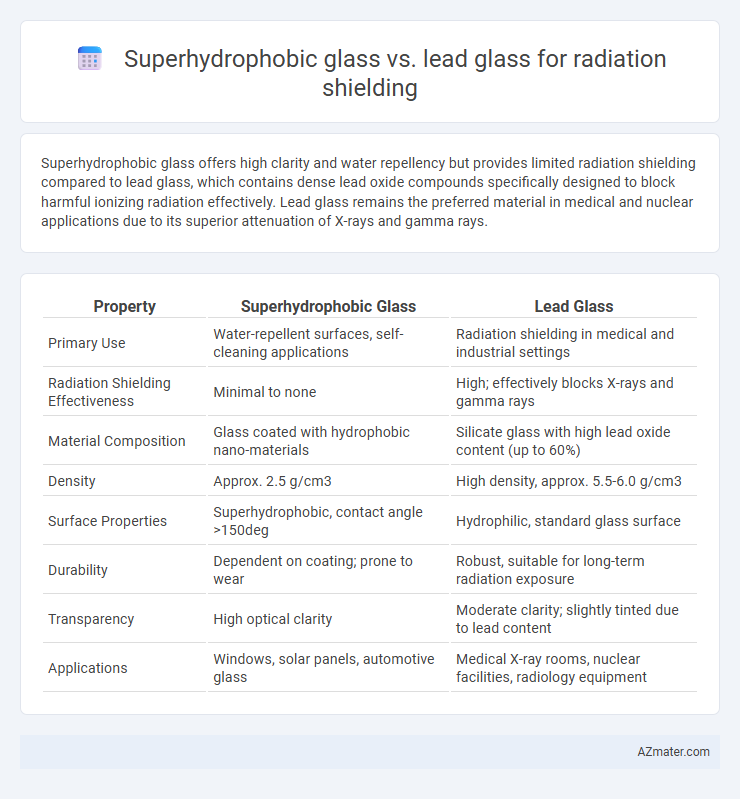Superhydrophobic glass offers high clarity and water repellency but provides limited radiation shielding compared to lead glass, which contains dense lead oxide compounds specifically designed to block harmful ionizing radiation effectively. Lead glass remains the preferred material in medical and nuclear applications due to its superior attenuation of X-rays and gamma rays.
Table of Comparison
| Property | Superhydrophobic Glass | Lead Glass |
|---|---|---|
| Primary Use | Water-repellent surfaces, self-cleaning applications | Radiation shielding in medical and industrial settings |
| Radiation Shielding Effectiveness | Minimal to none | High; effectively blocks X-rays and gamma rays |
| Material Composition | Glass coated with hydrophobic nano-materials | Silicate glass with high lead oxide content (up to 60%) |
| Density | Approx. 2.5 g/cm3 | High density, approx. 5.5-6.0 g/cm3 |
| Surface Properties | Superhydrophobic, contact angle >150deg | Hydrophilic, standard glass surface |
| Durability | Dependent on coating; prone to wear | Robust, suitable for long-term radiation exposure |
| Transparency | High optical clarity | Moderate clarity; slightly tinted due to lead content |
| Applications | Windows, solar panels, automotive glass | Medical X-ray rooms, nuclear facilities, radiology equipment |
Introduction to Radiation Shielding Materials
Radiation shielding materials like lead glass provide effective protection by absorbing and attenuating ionizing radiation due to their high density and atomic number. Superhydrophobic glass, while primarily designed for water repellency and self-cleaning surfaces, introduces novel functional coatings but lacks the inherent heavy metal content required for significant radiation attenuation. Selecting materials for radiation shielding depends on factors such as radiation type, intensity, and required transparency, where lead glass remains superior for shielding gamma and X-rays compared to alternative specialty glasses.
Overview of Superhydrophobic Glass
Superhydrophobic glass features a nanostructured surface that repels water, enhancing its durability and self-cleaning properties, making it ideal for environments exposed to moisture and contamination. While lead glass provides superior radiation shielding due to its high atomic number and density, superhydrophobic coatings can be applied to radiation shielding glass to maintain clarity and reduce maintenance. Innovations in superhydrophobic glass aim to combine water repellency with protective features, optimizing performance in radiation shielding applications without compromising transparency.
Properties of Lead Glass in Radiation Protection
Lead glass exhibits high density and significant atomic number due to its lead oxide content, providing superior attenuation of X-rays and gamma rays critical for radiation shielding. Its optical clarity allows effective visibility while maintaining radiation protection, making it ideal for medical and nuclear facility applications. The material's durability and resistance to discoloration ensure long-term performance in high-radiation environments.
Comparative Analysis: Superhydrophobic vs Lead Glass
Superhydrophobic glass offers advanced self-cleaning and anti-corrosion properties while maintaining effective radiation shielding, making it suitable for environments with high humidity and contamination risk. Lead glass excels in attenuation of harmful ionizing radiation, particularly gamma rays and X-rays, due to its high lead content, but lacks surface durability and requires careful handling to prevent lead contamination. Comparative analysis highlights superhydrophobic glass as a low-maintenance, eco-friendly alternative with moderate radiation protection, whereas lead glass provides superior shielding efficiency but with environmental and health trade-offs.
Radiation Attenuation Efficiency
Superhydrophobic glass exhibits enhanced radiation attenuation efficiency compared to traditional lead glass due to its advanced surface properties that reduce secondary electron generation and scattering. Its nanostructured coating provides not only hydrophobicity but also contributes to improved radiation shielding by minimizing photon penetration and enhancing energy absorption. Lead glass remains effective for gamma-ray attenuation due to its high atomic number elements but lacks the multifunctional benefits seen in superhydrophobic glass, making the latter a promising alternative for radiation shielding applications.
Durability and Chemical Resistance
Superhydrophobic glass exhibits superior chemical resistance due to its water-repellent surface, preventing corrosion and degradation in harsh environments, thus enhancing its durability for long-term radiation shielding applications. Lead glass, while effective at radiation attenuation, tends to be more susceptible to chemical wear and surface damage, leading to potential performance decline over time. The enhanced durability of superhydrophobic glass makes it a more reliable choice in settings requiring sustained exposure to corrosive agents and frequent cleaning.
Environmental and Health Impacts
Superhydrophobic glass offers enhanced environmental benefits by reducing chemical cleaning agents due to its water-repellent properties, thereby minimizing hazardous waste compared to lead glass used in radiation shielding. Lead glass, while effective at blocking ionizing radiation, poses significant health risks from lead toxicity during manufacturing, disposal, and accidental breakage, contributing to environmental contamination and lead poisoning. Advances in superhydrophobic coatings on radiation shielding glass aim to combine safety with sustainability by avoiding heavy metals and reducing maintenance-related environmental impact.
Cost and Manufacturing Considerations
Superhydrophobic glass offers advanced surface properties but involves higher manufacturing complexity and costs due to specialized coatings and treatments, making it less economical for large-scale radiation shielding. Lead glass remains a cost-effective choice with established production methods that efficiently incorporate lead oxide to enhance radiation attenuation. Manufacturers often prefer lead glass for its balance of affordability and shielding performance, despite environmental and health concerns linked to lead content.
Emerging Applications and Innovations
Superhydrophobic glass offers promising innovations in radiation shielding, particularly in environments requiring self-cleaning and anti-corrosive surfaces, enhancing durability and reducing maintenance in medical and nuclear facilities. Lead glass remains the industry standard for high-density radiation protection, but emerging applications leverage superhydrophobic coatings to improve surface longevity and transparency without compromising shielding efficacy. Recent advancements combine nanostructured hydrophobic materials with traditional lead glass to create hybrid shields that optimize protection while addressing environmental and operational challenges.
Conclusion: Choosing the Optimal Glass for Radiation Shielding
Superhydrophobic glass offers enhanced durability and self-cleaning properties, making it ideal for environments requiring minimal maintenance. Lead glass, with its high density and superior radiation attenuation, remains the preferred choice for effective radiation shielding, especially in medical and nuclear applications. Selecting the optimal glass depends on prioritizing radiation protection effectiveness over surface properties, with lead glass excelling in shielding performance.

Infographic: Superhydrophobic glass vs Lead glass for Radiation shielding
 azmater.com
azmater.com